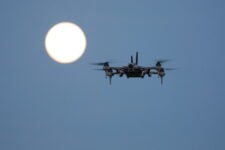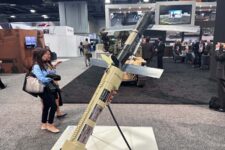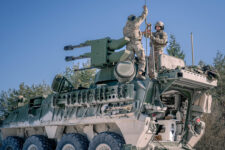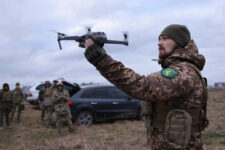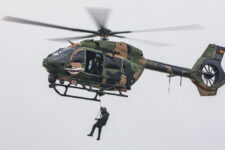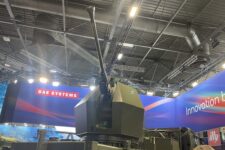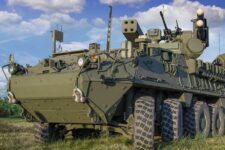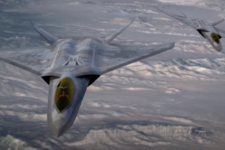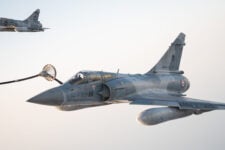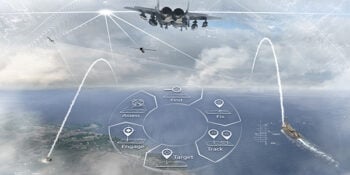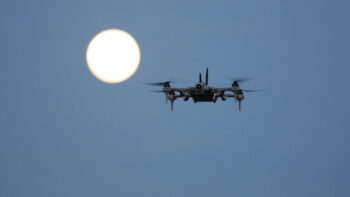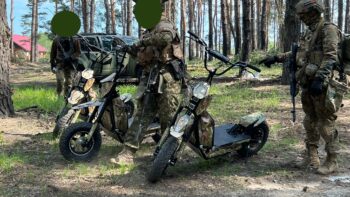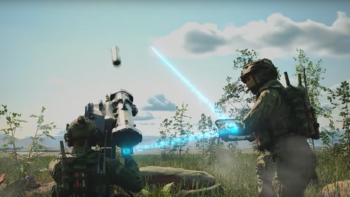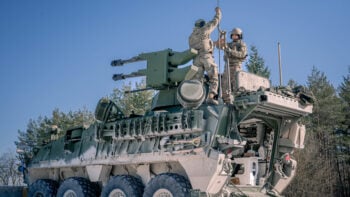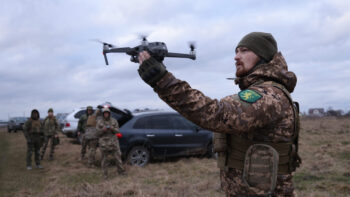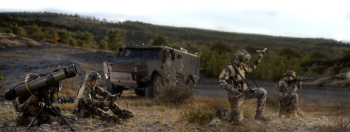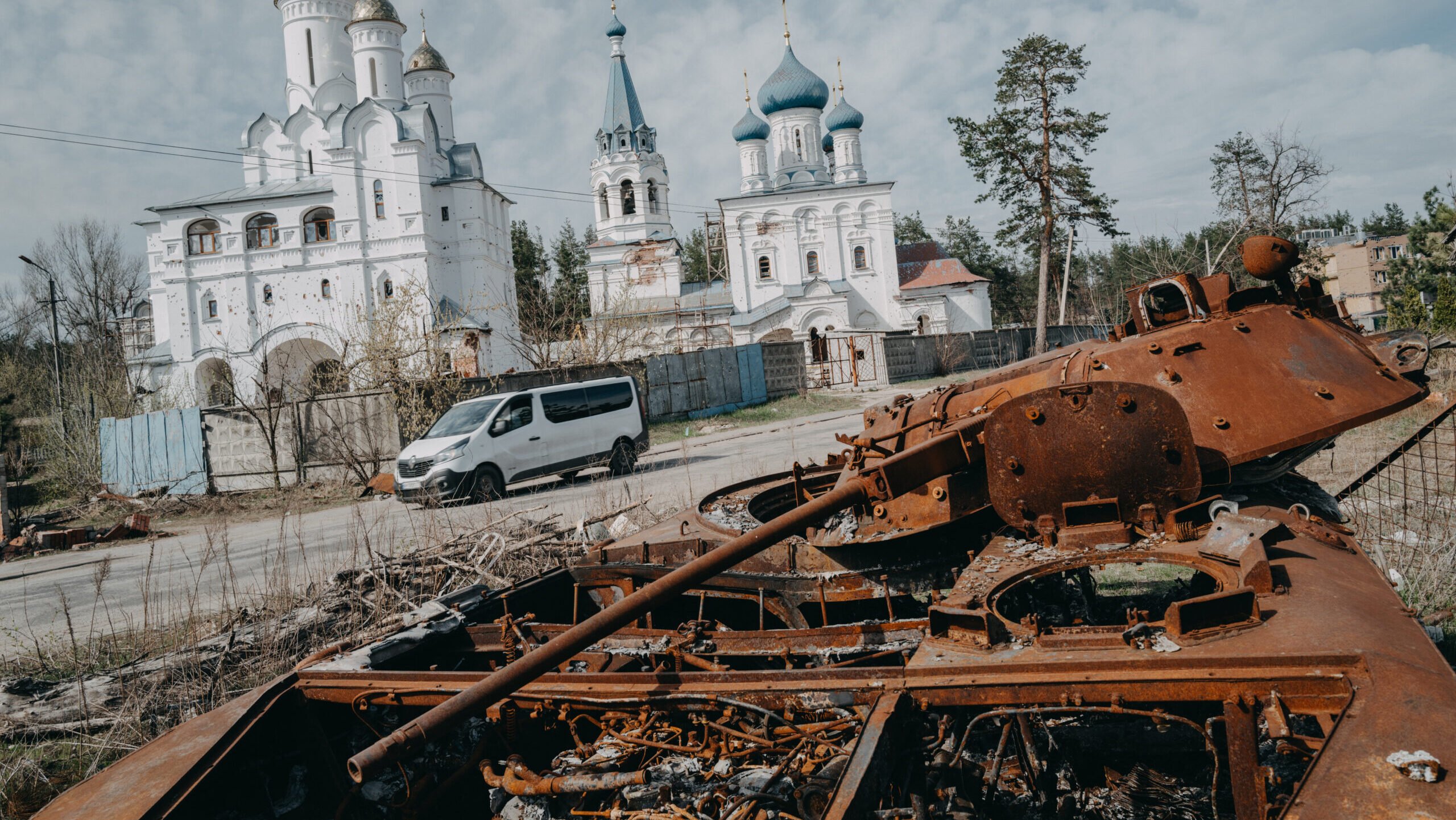
A view of the destroyed Russian tank parts as a church is seen behind while daily life continues in the shadow of the Russia-Ukraine war in Svitohirsk, Donetsk Oblast, Ukraine on April 06, 2024. (Photo by Wojciech Grzedzinski/Anadolu via Getty Images)
WASHINGTON — Loitering munitions and cheap “kamikaze” drones inside Ukraine have left a string of combat vehicles from both sides of the conflict smoldering on the battlefield. In many ways, the sight of Russian tanks being destroyed by small Ukrainian drones was the defining image of the early days of the conflict, and has left military leaders across the globe grappling with the lessons learned.
For the US Army, it’s been a crash course in how their own tactics and technology could end up on the wrong side of a war. Now, service leaders are rushing to incorporate lessons not just for today’s fight but for two key in-development tracked vehicles: the replacements for the service’s venerable Abrams tank and Bradley Infantry Fighting Vehicle.
If the Army fails to do so, it could end up plowing billions of dollars into systems that are dead on arrival on the modern battlefield. As a result, according to Brig. Gen. Geoffrey Norman, the director of the Next-Generation Combat Vehicle Cross Functional Team, the Army is focusing on what they see as the key new threat for ground vehicles.
FPV drones are now a “real problem” for all combat vehicles, he told Breaking Defense in an interview last month, along with other aerial threats like anti-tank guided missiles.
Helping to monitor the evolving threat is a team of technicians in Eastern Europe (not Ukraine) deployed there by the Program Executive Officer for Ground Combat Systems, according to the one-star general. There, he added, they are in regular contact with Ukrainian tank crews to “gain insights” on how a range of combat vehicles are being used and performing, and to keep up to date on the evolving threats from the skies, ground and electronic warfare realms.
“Those insights are going along with to inform our understanding,” Norman said, particularly when it comes to the two in-development vehicles.
On The Sidelines
To understand how the Army is adjusting its plans for the future Abrams and Bradley replacements, it’s important to step back and understand what two years of conflict in Ukraine taught planners in the Pentagon.
“You’re seeing with any vehicle that approaches the front lines [in] Ukraine is pretty much hit by a first-person view drone or something else now,” Stacie Pettyjohn, the director of the CNAS Defense Program, said in May during an event focused on counter-unmanned aerial systems.
Maybe the chief threat that the team is seeing comes in the form of small, low-cost (less than $500) first-person view (FPV) drones — some carrying an explosive payload. Typically, two soldiers control the aerial platform with one soldier donning a headset and operating it via a remote control while the second soldier uses a tablet loaded with maps to guide the drone.
Two decades earlier, the service wasn’t ready for the improvised explosive devices (IEDs) that littered the roads in Iraq and Afghanistan, so they quickly looked for ways to beef up underbelly protection. Today, the new problem is coming from above.
“UAVs are the IEDs of the sky: It’s just a mobile IED,” one industry source said. “We spent so much time in Iraq and Afghanistan handling the underbody. … And they’re still hitting mines and detracking… [but] crews are surviving.”
Fast forward, and Russia alone has lost close to 8,800 armored combat vehicles in the first two years of the Ukraine conflict, the International Institute for Strategic Studies (IISS) think tank reported in February. And as Russia has upped its drone production, Ukrainian vehicles have been victimized the same way.
That includes the 31 M1A1 Abrams main battle tanks the US sent to Ukraine. There has been a range of reporting about their effectiveness in recent months. In late April, for example, the Associated Press reported that Ukraine still had 26 Abrams active, but said they had been sidelined: the tank was an easy target for Russian drones. Subsequent stories note that the use of the Abrams on the battlefield is more nuanced, but the threat from drones seems to be clear. (More recent photos show Abrams there donning anti-drone armor screens dubbed “cope cages.”)
While Norman declined to discuss the specific details about Ukrainian military operations, he did acknowledge that the Abrams is learning some unfortunate lessons.
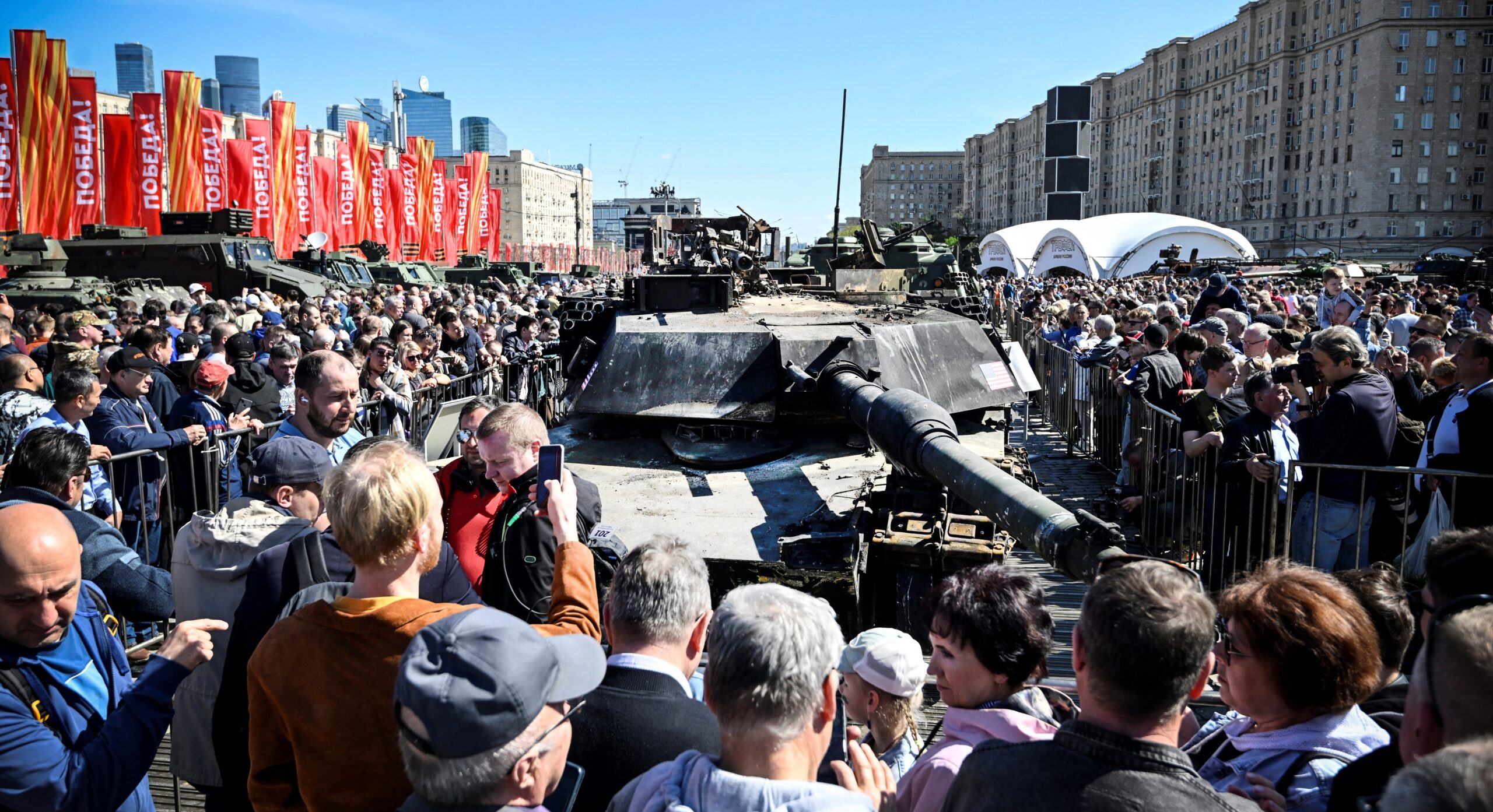
People look at US M12A1 Abrams tank captured by Russian forces in Ukraine, displayed at the WWII memorial complex at Poklonnya Hill western in Moscow, on May 1, 2024. The Russian Ministry of Defence opened an exhibition of samples of “Western weapons and military equipment” captured by Russian forces in Ukraine. The exhibition will last for one month. (Photo by Alexander NEMENOV / AFP) (Photo by ALEXANDER NEMENOV/AFP via Getty Images)
“Abrams is exceptionally well protected against direct fire threats, coming from other tanks and other fighting vehicles,” Norman said. But he later added, “The tank was not designed to be protected against the type of top-attack threats that are being seen now [in Ukraine], whether it’s from anti-tank guided missiles — that shoot down – or dive attack missiles or loitering munitions or the drones.”
Tactically, he said, the Abrams is meant to keep moving forward.
“The Abrams, and any main battle tank for that matter, is most effective when it can be employed in the offense, or in a situation where they can move around periodically,” Norman said. “It is a mobile protected capability that provides great mobility and firepower and it protects the group.
“When they stay stationary,” he later added, “they become vulnerable to any number of threats.”
To adjust, Army leaders have embarked on a multi-pronged approach that includes examining overall formation options to spread out capabilities and still protect soldiers. They are also looking for ways to upgrade existing platforms, like adding Elbit Systems-produced Iron Fist Light Decoupled active protection system to M2 Bradley infantry fighting vehicles.
And for vehicles still in the design phase, like the future Abrams variant and the Bradley replacement, they are using this moment to address the threats they are seeing in Ukraine.
Although light on specifics, Norman provided some overarching objectives that include better top protection, additional countermeasures like hard-kill and soft-kill active protection systems, laser dazzlers, as well as electronic options to better hide the vehicle’s signatures or jam incoming threats.
The service is also betting on its modular open systems architecture approach which is designed to enable it, and vendors, to more easily add in new software, sensors and capabilities over time.
The industry source said this will be key for adding in new software, sensors and capabilities over time, and providing commanders with more flexibility to outfit vehicles in one fleet differently. That approach is also coming in handy as industry designs two future combat vehicles.
Recreating The Tank
By September 2023, the Army had seen enough from Ukraine and announced it was shifting gear on its modernization of the main battle tank. Instead of proceeding as planned with a moderate upgrade called the Abrams System Enhancement Package version 4 (SEPv4), it opted to pursue a more ambitious upgrade dubbed the M1E3 Abrams, which once fielded will be called the M1A3.
The Army is interested in a lighter tank that also comes with better survivability and a smaller logistics footprint. Details are sparse, in part because the service is still working out its plans, but General Dynamics Land Systems (GDLS) remains the prime contractor.
Norman said there are currently multiple tech demonstrators “maturing subsystems as we speak,” and the service is relying on those to decide on everything from the future crew configuration to the powertrain.
He said it will likely take “several years” to pull everything together into a full-fledged prototype, which could come towards the end of the decade to meet the early-2030s fielding goal.
(In 2022, GDLS unveiled a lighter 59-ton Abrams X technology demonstrator to show the Army an alternative path for the SEPv4. Norman did not disclose if this was one of the ongoing avenues for exploring subsystem options.)
While Norman did not provide the Army’s M1E3 Abrams aspirational specifications, when it comes to protection he said the armor on the current tank is too thin to protect soldiers inside from those first-person view drones and other aerial threats seen in Ukraine.
“That’s one of the principal things that we’re addressing with the M1E3 effort, its top-attack protection: Its protecting the crew protecting the system, both from top attack, and then maintaining the sufficient protection against direct fire from the sides and the front and the rear, and then the under vehicle blast,” the one-star general added.
That top-attack protection will include a native active protection system to shoot down some types of incoming aerial threats like anti-tank guided missiles, rocket-propelled grenades and drones, he said.
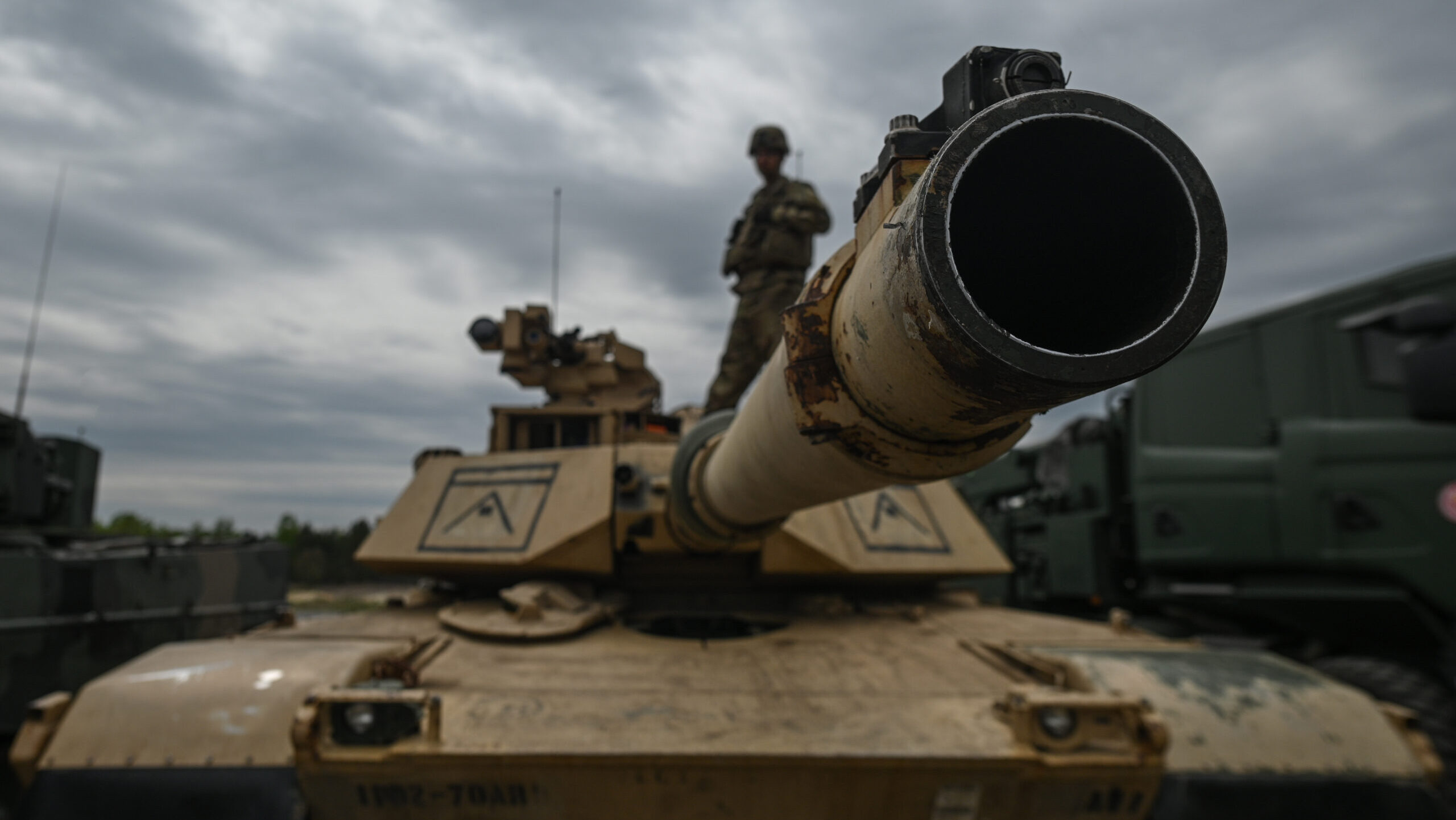
NOWA DEBA, POLAND – May 6, 2023: M1A2 Abrams tank seen before a high-intensity training session at Nowa Deba training ground, on May 6, 2023, in Nowa Deba, Poland. The Anakonda-23 exercise kicks off in Nowa Deba, marking the pinnacle of the Polish Army’s training calendar this year. From F-16 aircraft to W-3 SOKOL helicopters, GROM missile systems, RAK self-propelled mortars, KRAB howitzers, SPIKE anti-tank guided missiles, and LANGUSTA launchers, soldiers from various units in the Polish Army, along with counterparts from the United States, Romania, and Slovenia, will come together to train and collaborate towards achieving military excellence. (Photo by Artur Widak/Anadolu Agency via Getty Images)
Designing The Bradley Replacement
Army leaders have been eyeing different pathways for selecting and fielding a M2 Bradley Fighting Vehicle replacement for decades. In early 2020, they opted to cut bait on their third attempt when they canceled the initial Optionally Manned Fighting Vehicle (OMFV) prototyping competition because they did not have a suitable candidate that could meet requirements and timetable.
But they quickly moved on to the fourth attempt by launching a new OMFV competition with a more flexible set of parameters based around design characteristics and a slower schedule. The Army now has two finalists — American Rheinmetall and GDLS — and in May it began preliminary design reviews that are expected to wrap up later this month.
If all goes as planned, critical design reviews for what will be known as the XM30 are set for later this year and then the companies can move out on building seven identical prototypes that will be used for testing before a single victor is crowned in 2027, according to Norman and the industry source.
“In those design reviews are a formal process where the program office sits down with the vendor, and they go capability by capability through the designs,” Norman said. “We’re able to do that in a much more rigorous, and frankly, much more advanced manner now than we have previously because of the digital engineering [and] the digital environment.”
Once that design review period is over, Norman said the vendors will have a “good understanding” of Army requirements, whether their designs meet those requirements and if they need to make adjustments.
So far, Norman said there have been “no significant changes” to the combat vehicle’s requirements based on what is coming out of Ukraine — because the relaunched program came after the war had already started, giving the service time to incorporate lessons learned already.
“We were keeping a close watch on what’s happening in Ukraine to make sure that we had those requirements right,” he added.
While he didn’t go into specifics about each team’s proposal, he said the vehicles are being designed to withstand blasts from below and the top, once again with the specific loitering munition and FPV drone threat in mind. The designs also provide crewmembers with a “slightly larger” physical envelope, and include a hard-kill active protection system.
Rheinmetall and GDLS are proposing countermeasure packages that can shoot down threats, jam communications and “potentially hide the vehicle and prevent it from being seen in the first place,” Norman said.
“All of those things are in consideration and the vendors are figuring out which of those capabilities they should offer to the government in their proposals,” the one-star general added. “So we haven’t changed the requirements but we are very much in conversation with both vendors going through design reviews.”
The industry source said the two competitors are closely monitoring emerging threats as they finalize designs, asking for insights on Army combat vehicle formation changes and leaning on the modular open systems architecture (MOSA) for flexibility.
In a six-vehicle company, for example, do all of the XM30 platforms need a 50-millimeter gun, the source asked, along with a tube-launched, optically tracked, wire-guided (TOW) weapon systems and an active-protection system? Or is it better to provide the commander with flexibility to swap out some of those 50-millimeter guns with 30-millimeter ones that have a higher rate of fire, and swap out some of those TOWs and instead enable to the vehicle to fire Advanced Precision Kill Weapon System (APKWS) rockets?
So, the teams have performance specifications their prototypes must meet but can also fold in additional capabilities to meet additional threats, and propose a path for growth.
“How I’m looking at it now… is I’m still trying to shove additional capabilities into our 10-pound bag without adding additional cost and still meeting [performance specifications],” the source added. “How do we create flexibility for the Army… and use additional government furnished equipment? ‘Hey, look, you can adapt this here because you’ve already bought it here and you can put it on the vehicle to perform X.’”
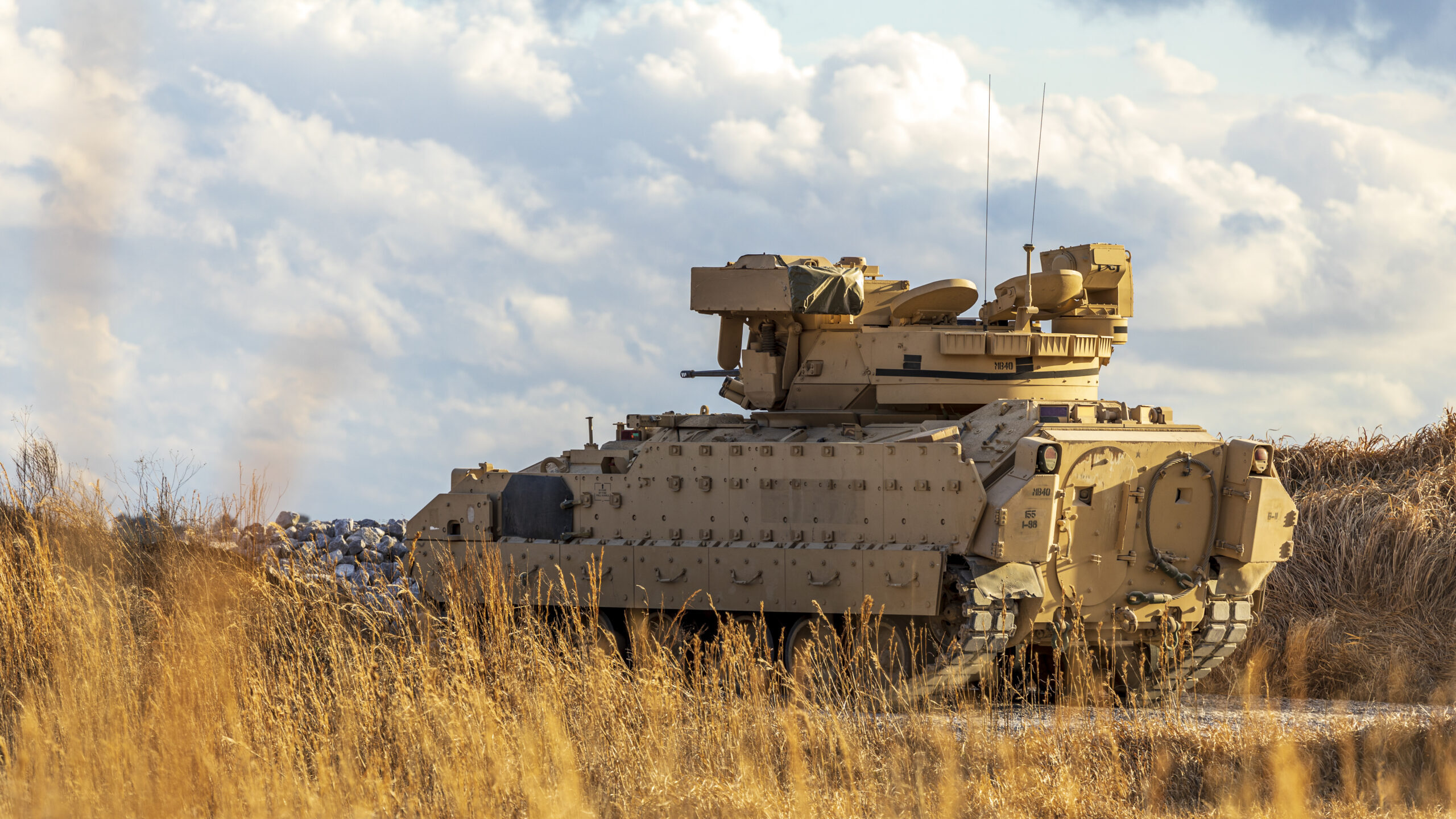
An M2A3 Bradley Infantry Fighting Vehicle prepares to fire on a range at Camp Shelby Joint Force Training Center, Miss., Feb 26, 2021. (U.S. Army National Guard photo by Sgt. Jovi Prevot)
Cat And Mouse
It makes perfect sense that the Army would want to incorporate feedback from Ukraine into its new designs. But history shows that today’s threats aren’t always tomorrow’s concerns, and soldiers will have to wait until the early 2030s to get their hands on the future Abrams and XM30.
Does that mean there is risk in focusing on Ukraine lessons for these new designs? There isn’t a crystal ball available to see if the Army’s combat vehicle bet will be enough to compete against future threats. However, last year the Army Science Board tried when it released a 58-page report on 2040 battlefield implications for 5th generation combat vehicles [pdf].
In it, they estimated that the service must make a $3 billion to $4 billion armor technology modernization investment “now” or “risk mission success in close combat.” Another takeaway was that the legacy M1 Abrams will simply not dominate on the battlefield.
“Regardless of the theater of operations, the lack of an overmatching [main battle tank] capability jeopardizes Army mission success,” the board wrote. “All of the M1’s advantages in mobility, firepower and protection are at risk,” it later added.
By and large, Army leaders agreed with the board’s findings, Norman told Breaking Defense during a December 2023 interview. Both agreed on the threat assessment, need for passive armor improvements, a greater reliance on software and desire to be more mobile.
However, the board and service leaders differed on two main items. First, Norman said the service doesn’t anticipate the same massive breakthroughs in material science the board does. The second point, service leaders believe the M1 Abrams will be relevant on the battlefield of 2040 and that’s the bet they are moving out on.
“That’s the fundamental disagreement that we have [with the board’s report] and that’s why we recommended to Army senior leaders’ strong consideration for an Abrams transformation [versus] the clean sheet design, and that’s the most important difference of our view,” he added.
Only time will tell if that bet pays off. For now, Army leaders will continue to watch Ukraine closely, and hope they are making the right decisions to protect soldiers on the future battlefield.
Red Cat unveils low-cost ‘family’ of small ISR, strike drones
The company revealed a new drone dubbed FANG and is championing a separate system the company is acquiring by buying manufacturer FlightWave Aerospace Systems.

